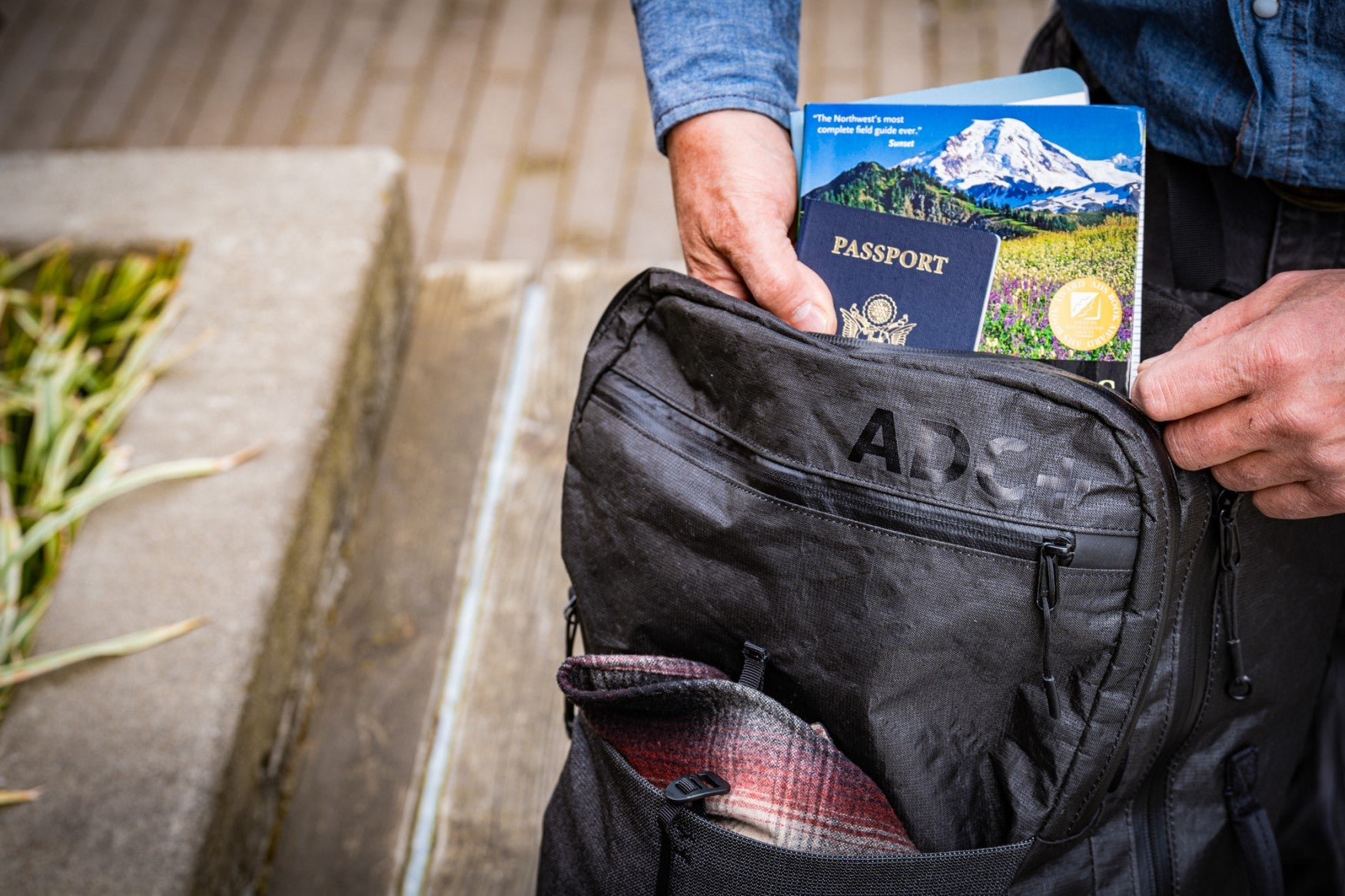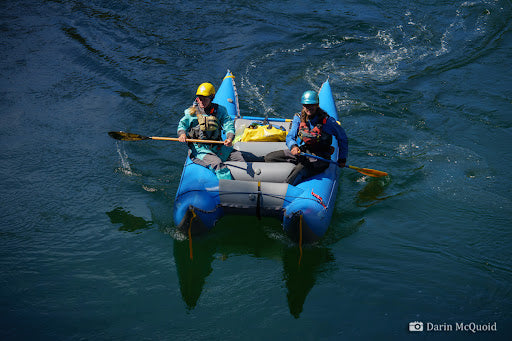Paddlers Sean Bowen and Nicole Smedegaard at the put in.
The North Fork of the American River is an epic playground of challenging whitewater rapids, including a 14.5 mile stretch that paddlers call Giant Gap. The actual gap is a river canyon sized slot between 2000 ft cliffs. At water level, the gorge feels like a shining arched stone gateway from a dreamscape. Write ups of this section are full of praise for the more than twenty class four rapids (and a few class fives), as well as the grandeur of the Wild and Scenic designated river corridor. It is a Sierras classic in the Tahoe National Forest, with sheer walled canyons, boulder gardens and a remote forested feel. However, the praise for this whitewater run is always followed by a lament over the access. The put in for Giant Gap includes a 1700 ft descent from Euchre Bar Trail Head over a distance of one and a half miles. In layman's terms; it’s steep! This trail I’m sure is a jaunty day hike down to the bridge where sweaty poison oak covered enthusiasts can jump into the ice cold deep green pools of the North Fork. As a raft put in though, it is a bit unconventional. The average river user must imagine wide open cement parkways gently sloping into sparkling waters on a hot sunny day at the “boat ramp.” Nope. The reality is that the Sierras are well known amongst the whitewater community for involving access points that are more likely to destroy your sled than the rapids are.

Hikers Nicole Smedegaard and Sean Bowen carry the raft folded and deflated inside a boat bag with a Six Moon Designs Flex Pack and all the paddling gear in a wobbly yellow NRS Bill’s Dry Bag at the Euchre Bar trailhead in Tahoe National Forest.
Wait, I thought we were going boating, not sledding? There are multiple schools of thought on how to get a raft down a trail, all of which we have tried, none of which are great. If the trail were shorter or wider, we could carry the raft inflated. Although rafts are full of air, they are surprisingly heavy! The boat my partner and I R2 (one raft, two paddlers) is 75 pounds and that’s if it’s dry. A typical hardshell whitewater kayak is in the 50 pound range, and then there is the kit: all of your paddling safety equipment like a PFD, helmet, throw bag, drysuit, first aid and repair. For a one day trip without overnight gear, my paddle partner and I are each looking at carrying half our bodyweight to get on the Giant Gap run. Gravity is helping here, so one idea is to sled the weight down the hill on a toboggan. The record setting snow year manifested on the retail front as the great toboggan shortage of 2023, but after some creativity, our crew found one and we decided to use it for the bigger yellow raft. The hardshell kayaker also chose the sled technique, setting up a leash system to control the descent.

Kayaker Darin McQuoid drags his kayak down the trail.

Sean Bowen takes a rest break with the raft inside the Six Moon Designs Flex Pack.

Nathan Hobbs, Scott Michael and Jacob Cruiser go caveman style with the yellow raft.
The sled worked until it didn’t, which was less than a quarter of the way into the hike. The blue plastic cracked, then broke after hitting the sharp rocks in the first portion of the trail. We quickly reevaluated the situation and decided to go caveman style, which obviously means dragging two sticks under the load. This worked and got our buddies’ yellow raft the rest of the way down the mountain. At the river’s edge we discarded the sticks back into the forest whence they came and smashed up the remaining blue sled bits, bagged them, and jammed the sad remains into the bottom of the raft.

The Flex pack with a 75 lb raft inside and a couple extra straps.
The best alternative to gravity assisted drag sledding is to pack in the boats on our backs. The advantages here are mostly for the boat’s sake. You can imagine what those sled shredding rocks would do to an inflatable craft! The problem with back packing the raft is its bulk and weight, finding a pack that can accommodate such an awkward load has always been an issue. We have tried external frame style hunting packs, but the frame is a bodily hazard while in difficult whitewater, getting chundered in a hole or flipping off a rock. Stashing a sled in the raft is also not ideal. NRS makes a pack that is meant to carry a dry bag, so we tried that last year but the straps were too short and the load wobbled and bounced, destroying my knees and my will to live. It also fell apart at the stitching and needed to be strapped back together with cam straps. For Giant Gap the best method we have found is a pack made by Six Moon Designs. The Flex pack is meant for packrafting. Technically, we are packing a raft; which surprisingly does not equal packrafting, which is its own sport. This pack solves several of our problems, it is small and soft enough to stuff inside a drybag and strap to the back of the boat for our day on the water. On the trail, it has stabilizer straps that keep the load close to your body and extra long load straps to circumnavigate our girthy boat. The hip belt and shoulder harness are padded out and comfy like a traditional through hiker pack. We didn’t try out the fancy water bottle holders for fear of adding any extra weight to the unsightly load.

Inflating the rafts at put in, finally at the water’s edge!
Once we get to the river, all the gear explodes into brightly colored piles of rubber as we begin to inflate the rafts. We shimmy into drysuits, double check hemet buckles, and push off into an adventure. Downstream we nervously await my favorite rapid of the run, Nutcracker. The R4 team in front of us disappears over the horizon line into shadows between two vertical walls. We drop in next and I say “we might want to square up to that one!” There is an enormous left hand lateral in the slot at our juicy flow of 1600 cubic feet per second. We crash through and are lifted high over the crest, skipping over the last hole and through the narrowest point at breakneck speed. We are all smiles, whoops and hollers as the crew makes it through successfully. The best feeling is right there with our friends, knowing we have a whole day of river adventure ahead.

Paddlers dropping into Nutcracker rapid, class V, on the Giant Gap run.











Leave a comment
This site is protected by hCaptcha and the hCaptcha Privacy Policy and Terms of Service apply.